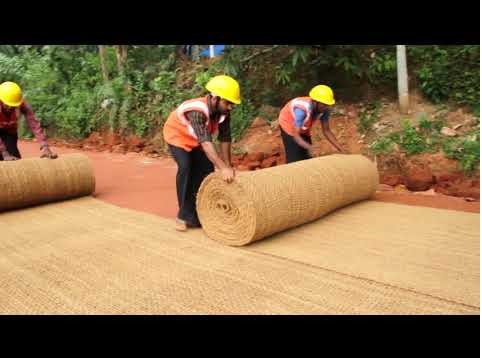
Coir geotextiles in roads – Indonesia as a tropical country has a large coconut production potential. The area of coconut plantations reaches 3,654,478 hectares with a total production of around 3,051,585 tons (DitJenbun, 2014), 99% of which are cultivated by small farmers. Not only for domestic consumption but several coconut commodities are also exported which brings in foreign exchange so that these commodities can be used as a source of the national economy.
Coconut plants have many benefits from young leaves, coconut flowers, coconut fruit, coconut tree trunks, even coconut tree roots can still be used as handicrafts, and much more. The fact, that the Scout organization uses the coconut bud for their official logo because of their philosophy that every part of the coconut tree can be used for human life. Hopefully, young scouts are expected to be useful for the Indonesian state and nation at every age.
The coconut plant is nicknamed the “Tree of Life” because all parts of the plant can be used. In Indonesia, coconut is an export commodity plantation product because it supports millions of people and makes it a very valuable asset for the country. Coconut is a social and economic good. So that when the price of these goods changes, it has a direct impact on the lives and livelihoods of farmers.
Read More: How to Make Cocoa Various Powder: The Manufacturing and Process
Utilization of Coconut Waste Product in Global Quality
As previously stated. Coconut plants have many benefits. This part of the coconut skin is no exception, which we usually call coconut husk. Based on data from e-smart school, coir is a large part of the coconut fruit, which accounts for 35% of the total fruit weight. Coconut coir is made up of fibers and the cork connects one fiber to another. Fiber is a valuable part of the coir itself. Each grain of coconut contains 525 grams of fiber (75% total coir) and 175 grams of cork (25% total coir).
Coconut coir is useful for improving soil structure and acts like a sponge to hold water that is useful for plants. Coconut water retention capacity is better than most other soil substitutes and can hold 7-10 times its weight. That way, coconut coir can be used as a planting medium and additional nutrients for the soil.
Along with the development of technology today, it turns out that coconut coir can also be processed into products with high economic value and even become a commodity that can penetrate the international market. One of them is cocomesh or geotextiles. The use of coir geotextiles is for the purposes of tackling critical land, reclamation of ex-mining areas, revegetation of sloping land and watersheds, and so on. By adjusting and modifying the shape and size of the coconut coir, it can be used for paving purposes.
Coconut Coir Geotextiles in Roads Application
The production of coir geotextiles is by crushing coconut coir waste coconut coir crusher machine. After the coir is cut into small pieces, it is then sieved using a coir sieving machine to produce separated fibers. This fiber is then twisted with a coconut coir rope spinning machine with a diameter that can be adjusted as needed.
After the rope is formed, then the coir ropes are woven to resemble a net. The density of this net can be adjusted as needed, please contact our customer service if you have special specifications from this cocomesh.
The material for making this Coir geotextile is cheap, easy to find, easy to apply in the field, and biodegradable. Coir geotextiles can be used also for geotechnical engineering or paving and can also be used as an overlay or innerlay. Can protect from runoff water flow, strengthen embankments, filtration and drainage.
Coir geotextiles are spread directly over the land to be used as roads. First, the ground is roughly leveled and then a coir-net is spread over it. Coir geotextiles are the alternative solution for paving roads because it is made from natural materials. The material is strong but can be degraded by the soil so it is safe for the soil ecosystem itself compared to a mixture of lime/lime, cement, etc.
Coir geotextiles in roads can also be used to improve poor soil nutrients because after it decomposes it becomes humus and is useful for plants. The application of coir-nets for paving roads has been successful in areas of high compressibility, sloping soils, road embankments, and soils that are at risk of abrasion and erosion.